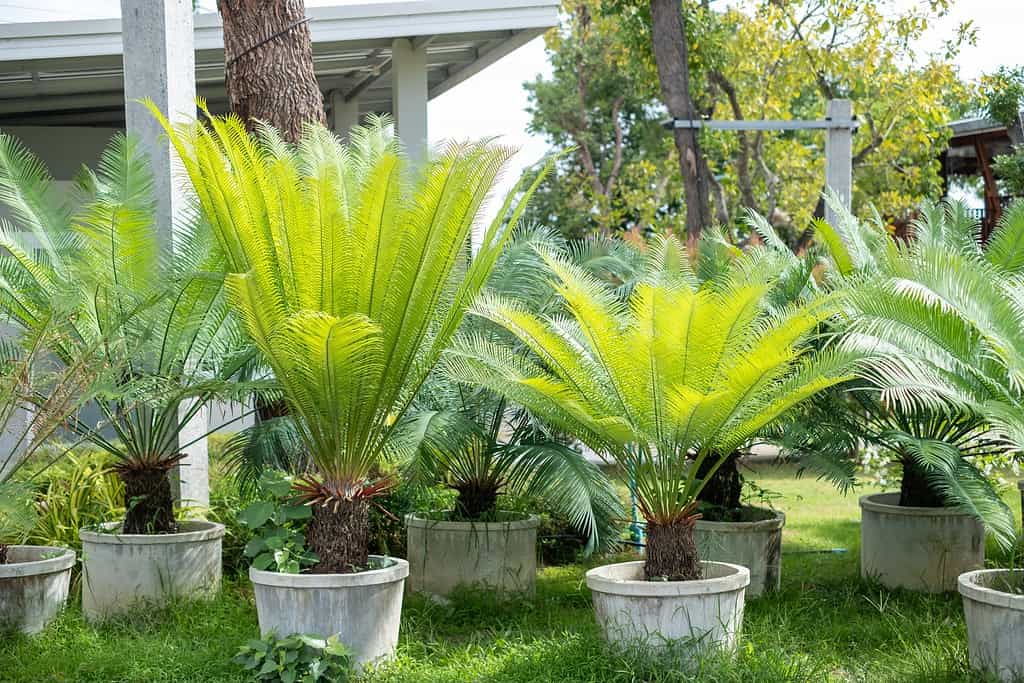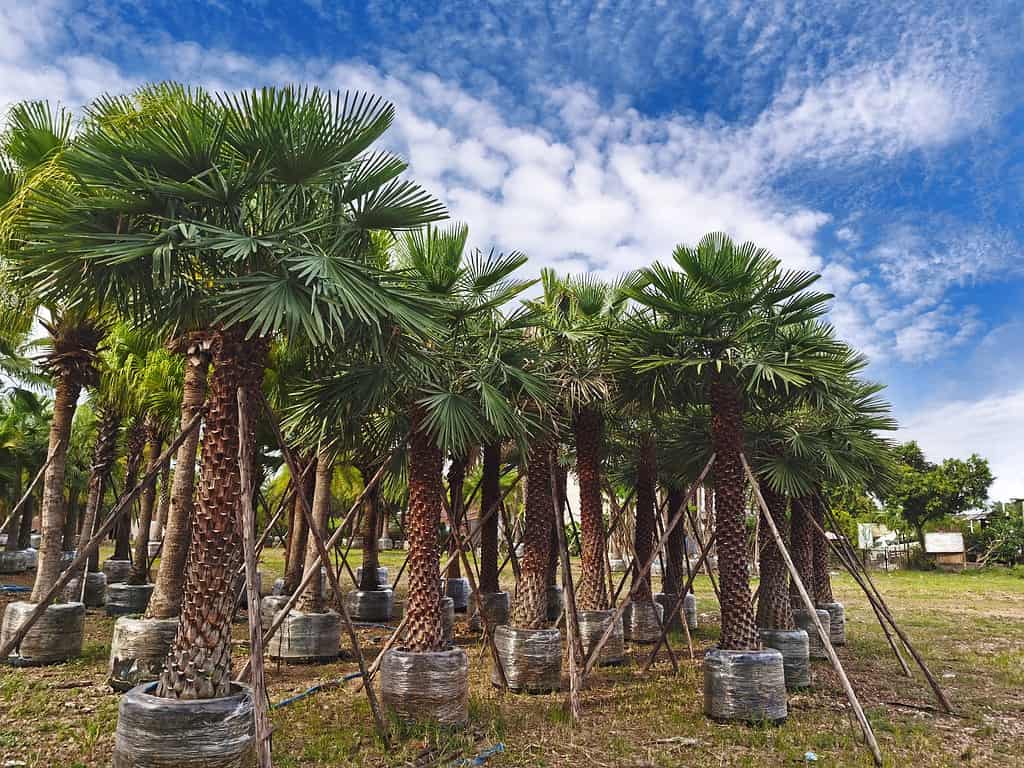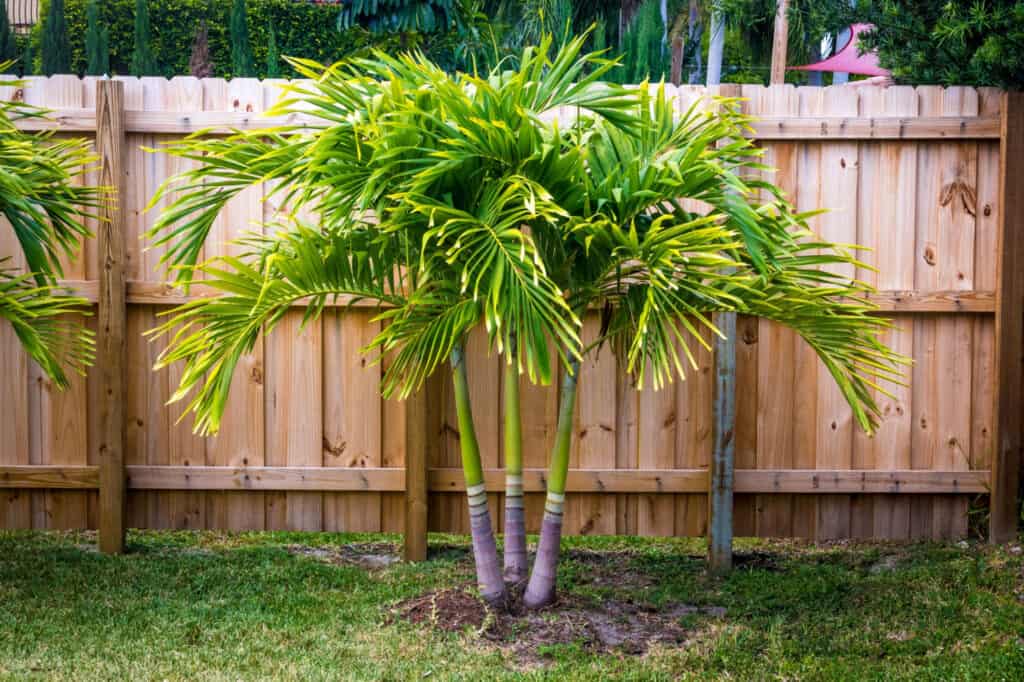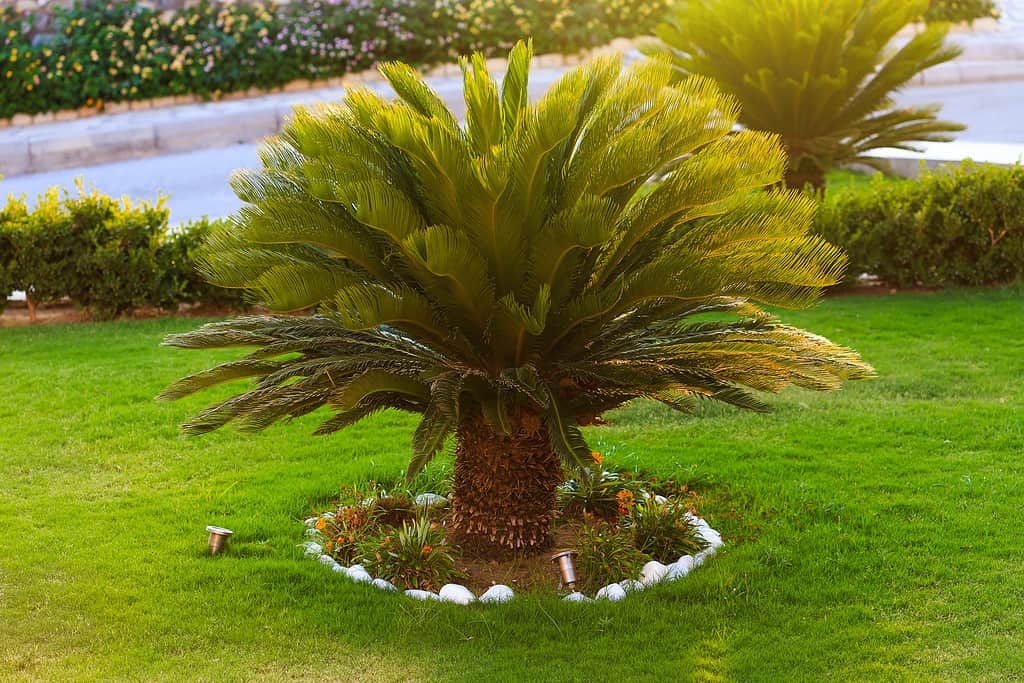If you’re considering planting a palm tree in your landscape, it is important to understand how its root system functions. How deep should you plant your palm? Should you trim palm tree roots when planting? Will the roots damage your home’s foundation?
In the guide below, we’ll address these questions as well as identify some of the unique features of palm roots. By the end, you’ll also know how to fix a couple of common issues with palm roots as well as how to best support a new transplant.
How Do Palm Tree Roots Grow?
The root systems of palm trees are quite different from those of other trees. They are dense and fibrous and grow from a specialized point at the base of the plant. Additionally, palm roots are constantly generating and replacing each other.
Because of their specialized root systems, palms are able to support themselves very well in environments where most trees would struggle. Let’s look at how these unique roots grow.

Palm tree roots emerge directly from a central growth point at the base of the stem.
©ISEN STOCKER/Shutterstock.com
Adventitious Roots
Palm tree roots are special in that they are adventitious. This means that they grow from a part of the plant that does not usually produce roots, like the side of the stem or the base of a leaf. In the case of palms, roots emerge directly from a central growth point at the base of the stem. This point is called the root initiation zone.
As a palm ages, its root initiation zone increases in size, becoming wider and moving up the base of the trunk. Eventually, the plant will begin to produce roots from above the ground. These roots often desiccate, or dry out, and cease to grow. However, if conditions become favorable, these roots can resume growth and eventually reach the ground. Sometimes, as the initiation zone grows upward, it can cause the trunk to take on appearances that may be concerning to the new grower. While some are indicative of disease, many of these changes are normal and are no cause for concern.
Interestingly, palm roots never increase in thickness from the time that they emerge from the trunk. Although they can stretch out for many feet, most palm roots will never grow much thicker than a ballpoint pen. Because they are thin and fibrous and never expand in size, palm tree roots are unlikely to damage your home’s foundation. They may, however, enter french drain piping or broken plumbing in search of water. Keep this in mind when choosing a planting location.
Width and Depth
Rather than spread far and wide like other trees, most palms produce shallow roots that stay pretty close to the trunk. Usually, they will not grow much wider in diameter than the crown of the palm. Some species, however, like the Bismarck palm, will send their roots as far out as 50 feet from their base.
Palm tree roots tend to stay close to the surface of the soil, rarely delving more than a few feet below the ground. This may be surprising to hear if you’ve ever seen a towering coconut palm weather hurricane-force winds. But while many tree species rely on thick, deep roots to keep them stable, the palm family has taken a different approach. Instead, most palms rely on a dense, superficial, and fibrous root network to anchor them to the ground. Because their root networks are so fine and tightly packed, they are very efficient at distributing the forces that act on their trunks.

While most palms produce shallow roots that stay close to the trunk, the Bismarck palm will send its roots as far out as 50 feet from their base.
©NizamRahman83/Shutterstock.com
Palm Tree Roots During Transplant
Now that you understand a bit about how your palm’s roots grow, we can talk about how to handle them during transplant. Because palms are unique from other trees, you will need to address common planting tasks in different ways.
Root Trimming
Different palm species respond in different ways to root trimming. Although some growers practice trimming when handling certain species of palm, the process is delicate and species-specific and can make or break a transplant. Some species, when young, will not survive a root trim at all.
In general, you should not trim palm roots before planting. Because the structure and generation of palm roots is different from other trees, pot-binding and tangled root masses are not an issue. Once planted, old roots will eventually be abandoned and replaced by new roots.
Watering Your Palm Tree Roots
Palm trees, like any other plant, will experience some level of stress during transplant. To help ensure that your palm’s transition into its new environment goes as smoothly as possible, you should make sure that there are no air pockets in the soil around its root ball. When backfilling the hole, use water to push soil into all the available space, including in between the roots. This will help minimize the amount that your soil will settle and will prevent water from filling large voids.
Your palm will also need a lot of moisture as it adjusts to its new home. To help ensure that water makes it to your palm’s roots, construct a shallow, raised ring of soil around the perimeter of your plant’s root zone. The ring will direct water inward toward the root ball and prevent it from spreading across the ground.
Be sure that your soil drains well, however, as you do not want to allow standing water to form. If the perimeter ring pools up and does not drain, you should reduce the amount of water you are using. Whether the ring pools up or not, be sure that you do not waterlog the soil as this can stress or suffocate your new palm. You are aiming to keep the soil evenly moist for several months until your plant has established.

Some growers will trim the roots when handling certain species of palm, the process is delicate and can make or break a transplant.
©nopparada samrhubsuk/Shutterstock.com
Planting Depth
Because potting soil can shift, settle, and decompose over time, it is possible for the root initiation zone of a containerized palm to become uncovered. When this happens, the base of the palm may appear to “hover” above the soil surface.
When the root initiation zone becomes elevated, new roots that the young palm produces are not likely to reach the soil. This means that the plant is unable to generate additional support. The nutrient transport and support of the palm are then left to a small number of fibrous roots. As the plant becomes taller and heavier with age, this will lead to severe instability of the palm. Eventually, plants with poorly anchored initiation zones will fall over.
To prevent this from happening, be sure to bury all of your palm’s roots at the time of transplanting. The base of the trunk where the root initiation zone begins should be placed about an inch below the surrounding soil. Don’t fret if you’ve already planted your palm too shallowly — you can fix it without digging it up. Simply mound up dirt around the root initiation zone until you reach the base of the palm’s trunk. This allows the exposed roots to revive over time and grow downward into the soil, properly anchoring your palm.
Palm roots are particularly susceptible to suffocation and rot. While you must ensure that you properly cover your palm’s root initiation zone, it is crucial to avoid planting your palm too deep. If the base of your plant’s trunk is too far below the surface of the soil, its roots will not receive enough oxygen. Be sure not to bury the root initiation zone deeper than the recommended inch.

Be sure not to bury the root initiation zone deeper than the recommended one inch to ensure the roots receive enough oxygen.
©julie deshaies/Shutterstock.com
Supporting the Palm
Newly transplanted palms, if they are tall, will need extra support until their roots have re-established. The length of time that a palm requires support will vary from species to species but is usually between several months and a year.
To help keep your plant upright, you should use angled supports. One method of supporting a transplanted palm involves tightly strapping blocks of wood to the trunk with a buffering material in between to prevent abrasion. Instead of nailing or screwing supports directly into the trunk, you can attach your supports to these blocks. Once the palm is able to bear its own weight, the blocks, buffer material, and supports can be easily removed by cutting the straps.
By supporting your palm this way, you can plant it at the proper depth without worrying about it falling over. You also avoid injuring your palm which prevents insect pests and trunk rot from taking hold.
What Are the Best Palm Trees to Grow in North America?

A sago palm tree grows well in North America.
©Cristi Kerekes/Shutterstock.com
1. Date Palm – This is a common outdoor palm tree in North America that can reach heights of up to 80 feet or more. Its fronds are blue-green and fan out from a single trunk as it matures. It also produces yellow dates, making it a popular choice for landscaping as well as edible fruit production.
2. Coconut Palm – The coconut palm is found in many tropical regions, but if you live in the warmer parts of the United States (such as Florida) it can be grown outdoors. It is a tall palm tree that produces long, feather-like fronds and large yellow coconuts.
3. Windmill Palm – This cold hardy species of palm is native to Japan but grows well in North America as far north as USDA Zone 6. Its fan-shaped fronds are green on top and silver underneath, giving the tree an attractive appearance even in winter months when other palms may look dull or dead. The windmill palm is slow-growing but can eventually reach heights of 20 feet or more.
4. Sago Palm – The sago palm is a popular landscaping choice in North America because it’s easy to grow and requires little maintenance once established. It has a unique, symmetrical look with its spiky fronds radiating from the center like spokes on a wheel. This species grows best in warm climates and prefers full sun exposure for optimal growth.
5. Bottle Palm – This species of palm is native to Madagascar and is often used in tropical-themed landscaping because of its unique, bottle-shaped trunk. It can tolerate cold temperatures down to 15 degrees Fahrenheit, making it a good choice for gardeners in colder climates. The bottle palm grows slowly but can eventually reach heights of up to 20 feet with multiple trunks forming an impressive clump over time.
The photo featured at the top of this post is © pinholeimaging/Shutterstock.com
Thank you for reading! Have some feedback for us? Contact the AZ Animals editorial team.






